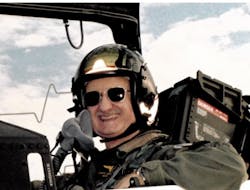Hats off to Benét Wilson and her article, “A.A.E. Credential: A Career Changer” (Airport Business, Vol. 31, No.2, pp. 24-25). Twenty-five years ago, I was also in my mid-30s and only months away from completion of my own accreditation. As such, let me add my own personal kudos to Sarah Demory, A.A.E. and Marquez Griffin, A.A.E., for their noteworthy accomplishments!
Although my current engagement in aviation is national defense-centric, I still track the airport industry and maintain contact with a number of senior executives, both accredited and non-accredited. As such, I was somewhat surprised, and in some ways both pleased and at the same time disappointed, to learn of some of the changes in the requirements for AAAE accreditation between then and now.
For example, for my peer group at my first airport, although all but one of us already held master’s degrees, we were all still required to research and write a postgraduate level management paper on some aspect of airport management that would remain on file in the AAAE Library in Virginia, permanently available as a research tool to others in the profession. Second, all of us also had to have a minimum of a year of experience at a civilian public-use airport before we could even declare our candidacy and start AAAE’s accreditation program (at the time, for those of us with military aviation backgrounds, experience at an air base didn’t count). Third, we all had to have at least 3 years of experience at a civilian airport before we could officially be accredited. Finally, from the day we started the program, we had a maximum of 3 years in which to complete all A.A.E. requirements. Exceeding that time limit was by exception, contained administrative penalties, and was generally disdained.
Now this is not to diminish the accomplishments of Sarah, Marquez, and all others who have completed the A.A.E. qualification process under the revised requirements. However, several of us who are alumni of the earlier guidelines wonder what level of intellectual rigor the AAAE leadership applied in making these changes. Certainly, Sarah’s thesis for her MS degree in aviation likely had as much, if not more, applicability than a management paper, but the current requirements merely state that “…proof of an advanced degree,” will suffice in lieu of the management paper. By that logic, an attorney with a JD degree and no prior aviation/airport experience can also exempt the management paper requirement. Ergo, were the previous requirements truly a barrier to motivated, prospective A.A.E.s? Or were some of these changes done to ease acquisition of the A.A.E. credential by more senior individuals at major airports, especially those with limited to nonexistent aviation backgrounds, and who often entered the airport management field in senior executive capacities via political appointment without ever having had spent any time “in the trenches” in aviation?
Despite this, my takeaway from Benét’s article was one of guarded optimism, e.g., that the A.A.E. credential is finally being perceived as a viable “career changer” and perhaps gaining a wider recognition in the industry as to its overall value. This was not necessarily the case, at least in my own personal experience and that of most of my peers, a quarter century earlier.
People enter the airport management profession from various paths. Some like Sarah enter from college and/or graduate school, often with a concurrent internship at an airport. Others like Marquez enter non-flying positions with FBOs or the airlines and later migrate to the airport side, squeezing in college and possibly graduate school while working full time.
In my case, entry came through a flagship state university, followed by a dozen years as a naval officer and aviator flying combat aircraft and performing concurrent aviation staff and support functions, all topped with a Navy-funded postgraduate degree. Leaving active duty, I interviewed with several Class I airports before joining the operations staff of the major international airport in the community where I had grown up, hoping to be that example of the local boy who comes home and makes good. At the same time, I retained my commission as an officer and concurrently flew combat aircraft several days a month in the Naval Air Reserve. Following a year of airport experience that included every day of the week and every hour of the clock, I declared my candidacy for accreditation.
Four of us at my airport all achieved A.A.E. accreditation during the same week nearly a quarter century ago and were the first “in house” A.A.E.s our airport had ever produced. Yet by the end of the year, and for 5 years thereafter, there was no measurable “career changer” effect for either myself, nor for all but one of my fellow A.A.E.s, the sole exception having previously ingratiated himself to an influential “sponsor” within the airport’s senior leadership. In fact, despite repeatedly applying and interviewing for positions of increased responsibility within the airport’s organization, the rest of us continued to be severely underutilized while a revolving door of “connected” individuals with minimal to no aviation or airport expertise would pass through the organization in senior executive roles.
In short, what I and my fellow A.A.E.s were not adequately prepared for was the level of nepotism and political cronyism that frequently outweighed all aspects of ability, competency, aviation experience, and professional accomplishment as the key to upward mobility and career advancement at our airport at that time. In my case, after becoming fully vested for retirement purposes, I reluctantly resigned in order to accept the #2 position at a smaller regional airport over 70 miles away.
My new job wasn’t much of a pay increase and, with the added daily commute from my home, was almost a pay cut. But for the initial months, it was highly motivating to be the #2 of a regional airport that had hired me to take their Limited FAR Part 139 facility and make it fully capable for Part 121 air carrier operations. I hit the deck running with plans to make my new airport a gem. Unfortunately, my “big airport” methodologies, so warmly embraced by the city’s and county’s business and economic development community, didn’t mesh well with a very reluctant city hall and an often fractious relationship between the then-city manager and my boss, the then-airport director. Cronyism and nepotism also began to rear its head again, just with a different cast of players!
So, when “Big Navy” asked if I would consider returning to full time active duty as a senior officer, I didn’t hesitate to accept the offer, the immediate impact of which was more than doubling, and later tripling, my income over what I was earning in airport management. Returning to both Naval Aviation and the wider military community, I never looked back, eventually commanding an organization of over 1000 people and remaining in uniform until reaching mandatory retirement.
So what does that have to do with the A.A.E. credential today? As I said earlier, I remain optimistic that Sarah and Marquez represent a newer perception of the credential versus that of my peers and I who, through no fault of our own, were often perceived as professional threats to certain individuals above us, especially those who were “politically advanced” to their positions with often marginal qualifications.
So what pearls of wisdom would I offer to Sarah, Marquez, and the dozens of other young A.A.E.s out there, as well as those who are currently pursuing accreditation?
First, if you have a direct role in airport operations, as many young A.A.E.s do, never lose sight of the fact that your overarching “mission” is the safety and security of those visiting, transiting, operating or flying an aircraft to or from, or working at your airport. Yes, I understand all the competing demands of customer service, finance/revenue generation, air service development, construction management, community relations, and the rest. But deterring injury and loss of life must always be at the forefront of your focus. If you ever have to deal with a fatal military aircraft mishap or an ALERT 3 with a partial belly landing by a commercial jetliner full of passengers…and I’ve dealt with both…you’ll understand what I mean!
Second, be willing to be totally candid with superiors and subordinates alike! One of my former senior directors (who later became Executive Director) once told me, “I’m not telling you to lie, Jim, but you’re incredibly candid in an organization that doesn’t handle candor very well!” That may be true, and it may have had an adverse impact on my career at that airport vis-à-vis those who placed political considerations ahead of operational or ethical ones. But years later, as I told my squadron commanding officers…all of them highly experienced Naval Aviators…when I assumed command of our air group: “Be candid, because this is aviation, and in our business, a lack of candor will get people killed!”
Third, seek out mentors and strive to be a mentor yourself! Sarah certainly seems to have had one in Rebecca Hupp, A.A.E., and I suspect Sarah is a role model for the generation following her. I suspect Marquez may be doing the same. In contrast to civilian airport management, in the military we have what’s known as an “up or out” career path. Either you continue to promote in rank and advance in responsibility or you’re forced out. Eventually, everyone is forced out, even 4-star generals and admirals, due to mandatory retirement dates based on rank and years of service. As such, one of our principal roles as leaders in military aviation is to groom our subordinates as the next generation to follow us. So, if you’re an A.A.E. in a leadership role, are you identifying your “young tigers” in your organization who wish to advance? Are you setting them up for success and preventing them from being pigeon-holed or benched? Are you grooming them to eventually succeed you and your contemporaries?
Fourth, be an advocate! This falls in line with being a mentor. At your airport, particularly if you’re an executive at a large airport, are you engaging your colleagues and advocating for your subordinates (or others you may be mentoring) for possible in-house promotions within or to other departments? Or does your organization “stove pipe” your people, unwilling to utilize them to their fullest potential? Is your college-degreed and possibly accredited subordinate viewed as just a “technician” or an “ops guy” or “ops gal” by other leaders in your organization because their lesser-qualified predecessors were characterized that way?
Does your senior leadership apply a “management by the lowest common denominator” approach, e.g., if you have several college graduates and grad school graduates along with a few holdover high school only or GED graduates in a given division, is senior leadership perceiving the entire division as comprising just a bunch of high school only graduates with no future executive potential?
The flip side of being an advocate is that sometimes you may have to be brutally honest. There may be instances where your guy and/or gal is the most qualified and the most obvious choice for an in-house promotion. They may have aced the interview, but they still don’t get selected. Why? Because someone higher in, or external to, the airport organization has a personal agenda and a candidate who they intend to be the selectee no matter what. It was a “done deal” before the vacancy announcement was even posted!
In these cases, you need to be both honest and substantive with your “mentoree.” The harsh truth of the matter is that in some instances, a given airport may not be willing to promote from within or from a particular department or division. Your operations supervisor may have an MBA in finance and be a superb pick for a finance manager post. Or your community relations assistant may have just completed a BS in aviation management, earned a pilot’s license and wants to come to operations. But no one in senior leadership can see past the “ops guy” or “tour gal” imprimatur. In this case, even though they may be one of your star performers, you may have to recommend that they “move out” of your airport in order to “move up” professionally.
Finally, and this is probably your toughest challenge, many of you will eventually face a point in your career where you must choose a course of action that pits your reputation and professional ethics against that which is politically expedient. Will you be willing to “lay it on the line” and possibly risk your own career? Or will you become a “political” careerist, employing a “go along gets along” approach, willing to sacrifice your ethics, your subordinates and your colleagues along the way? Which path will you take? What will you do?
None of this is easy, but nothing worthwhile ever is. So for Sarah, Marquez, and the rest of you credentialed and aspiring A.A.E.s out there, my best wishes to all of you! Stay focused, stay motivated and PRESS ON! The future of airport management rests in your hands!
Jim Philpitt, A.A.E., is a retired Captain in the U.S. Navy, whose 30-plus years of military service spanned the Cold War to Operations ENDURING FREEDOM and IRAQI FREEDOM and included command of an air group of eight squadrons. A civilian pilot since age 16 and a Naval Flight Officer with over 3600 flight hours in strike and reconnaissance aircraft, he holds a BS in Government from Florida State University, an MPA in Public Administration from the University of West Florida, and additional postgraduate diplomas from the U.S. Naval War College, the USAF Air War College, and the Joint Forces Staff College. An Executive Emeritus member of AAAE, he has been an A.A.E. since May 1992 and is currently a senior planner in support of a combatant command of the U.S. Department of Defense.





